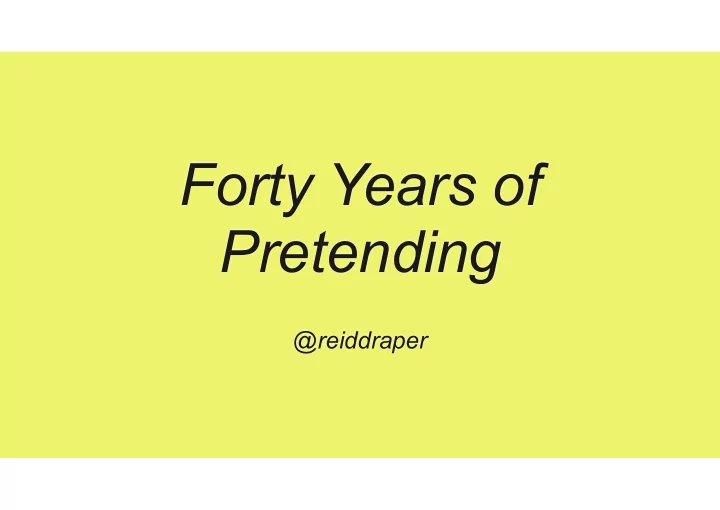

Forty Years of Pretending @reiddraper
About me
Eng. @ Basho @reiddraper
Nobody ever got fired for making an RPC call
RPC claims transparency between local and remote procedure calls
This abstraction fails
Even a simple web app is a distributed system
A resurgence with Javascript
RPC
History
Pretending
Today
Tomorrow?
RPC
R emote P rocedure C all
[ … ] RPC mechanism is one in which local procedures and remote procedures are (effectively) indistinguishable to the programmer. - Nelson
[ … ] the calling environment is suspended, the parameters are passed across the network to the environment where the procedure is to execute [ … ], and the desired procedure is executed there. [ … ] the results are passed backed to the calling environment, where execution resumes as if returning from a simple single-machine call - Nelson
A synchronous network call does not make RPC
send(2) is not an RPC call
transparency between local and remote procedure calls
Motivation for RPC
Distributed systems are hard
The procedure call is familiar
Let's lift distributed programming to the procedure call abstraction
Let's lift distributed programming to the method call abstraction
Let's lift distributed programming to the function call abstraction
History
Telnet
RFC 674 1974 Postel and White
P rocedure C all P rotocol
RFC 707 1976 White
R emote P rocedure C all
The principal goal of all resource- sharing computer networks, including the now international ARPA Network (the ARPANET), is to usefully interconnect geographically distributed hardware, software, and human resources - White
It forces upon the user all of the trappings of the resource's own system. - White
It provides no basis for bootstrapping new composite resources from existing ones. - White
Xerox Remote Procedure Call XML-RPC RFC 674 CORBA v1 2014 1974 1981 1991 1998 1970 1976 1984 1995 2003 RFC 1831 RFC 707 SOAP Implementing Remote Procedure Calls
An alternative history
The Actor Model 1973 Hewitt
RFC 684 1975 Schantz
[ … ] objection to the"PCP philosophy" - Schantz
RPC blurs the line between local (cheap) and remote (expensive)
RPC blurs the line between local ( cheap ) and remote ( expensive )
[ … ] a model which relies on procedure calling for its basis does not take into account the special nature of the network environment - Schantz
[ … ] and that such an environment can be more suitably handled in a message passing model. - Schantz
Goes on …
A Critique of the Remote Procedure Call Paradigm 1988 Tanenbaum van Renesse
Implementing Distributed Systems Using Linear Naming 1993 Bawden
RFC 2616 (HTTP 1.1) 1999 Fielding et al.
REST 2000 Fielding
Problems with RPC
Consistent code
How do you atomically update the code?
Handling failure
What if the remote node never responds?
Or the underlying TCP connection is closed?
Did it fail halfway through?
Did it fail right before it returned to us?
Why don't we have a stacktrace?
What if our procedure made another RPC call?
Serializing values
How do you serialize a file- descriptor?
How do you serialize a database connection?
The streaming problem
Can we start processing partial results?
The continuation problem
The procedure call only models A->B->A communication
(8) Fallacies of Distributed Computing
Fallacies of Distributed Computing
1. The network is reliable
2. Latency is zero
3. Bandwidth is infinite
4. The network is secure
5. Topology doesn't change
6. There is one administrator
7. Transport cost is zero
8. The network is homogeneous
Today
Javascript and compile-to-Javascript
Code sharing!
Coupling
Even a simple web app is a distributed system
meteor.js derby yesod-fay shoreleave hapstack dnode now.js nodejs-light_rpc
Tomorrow
The principal goal of all resource- sharing computer networks, including the now international ARPA Network (the ARPANET), is to usefully interconnect geographically distributed hardware, software, and human resources - White
Distributed systems are still hard
Implementing Distributed Systems Using Linear Naming 1993 Bawden
Bloom (UC Berkeley)
Questions @reiddraper
Recommend
More recommend